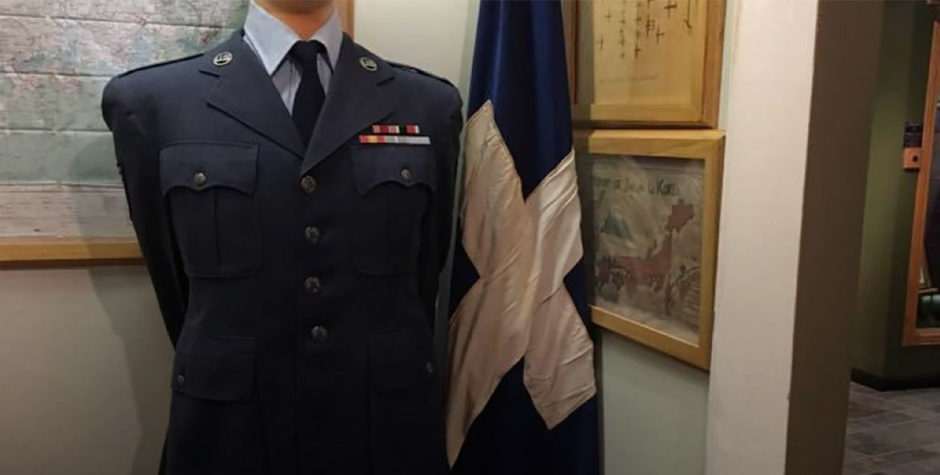MRFF Attacks a Christian, The Chaplains’ Flag, a Cross, and an Air Force General
In the latest attack by Mikey Weinstein and the Military Religious Freedom Foundation (MRFF), the target is not only the United States military (MRFF’s venomous specialty) but is also an attack on history, in this case the history of the Korean War.
At Maxwell Air Force Base in Alabama, there is a museum that is part of Air University, the Air Force Enlisted Heritage Research Institute. At issue is a display that was dedicated on November 5, 2012; it has been in place at the Institute ever since. A portion of the display highlights the dedication and heroism of Air Force personnel in the Korean War and commemorates the actions of a chaplain’s assistant, Staff Sergeant Merle (Mike) Strang. There is a Chaplain’s Flag in the display, as well as a chaplain assistant’s uniform. However, this is only one part of the display about that war. There is also a radio operator, medical equipment, a footlocker that U.S. Airmen would have been issued at the time, and more items. It is all part of a larger display about the Korean War, 1950-53.
The Air Force initially had a plaque near the chaplain assistant display, because they had been incorrectly informed that the chapel flag had been found in an abandoned chapel in what is now the Demilitarized Zone between the two Koreas. Enter Weinstein and the MRFF: they sent a letter demanding that the plaque be removed because they contended that it was historically inaccurate since it did not date back to the Korean War era. After some research, the Air Force agreed and the plaque was removed.
Then on October 27, 2017, Weinstein sent a letter to the commanding general at Maxwell vehemently demanding that the chapel flag also be removed. While Weinstein calls it a “Christian Flag” and characterizes the Air Force Enlisted Heritage Research Institute Korean display as “nothing more than a pretextual attempt to proselytize the Christian faith to the exclusion of any and all others,” it is actually a Chapel Flag. Every military chaplain is issued a flag as a part of their deployment equipment that represents their particular faith group: a cross on a flag for all Christians, a Torah and a Star of David for Jews, a Crescent for Muslims and so forth. A chaplain’s flag is flown near the tent or other facility where a chaplain conducts religious services so that military personnel know where the service is, as well as the location of the chaplain and his or her assistant.
Because Staff Sergeant Mike Strang was a “Christian” Chaplain’s Assistant a “Christian” Chapel Flag is in the display. His chaplain, (Colonel) Russell Blaisdell, a Lieutenant Colonel at the time was also a Christian as well. These two men are part of a very noble and famous Unit Ministry Team during the Korean War. And they flew an identical flag to mark their location as they traveled in Korea.
In the winter of 1950, there were over 6,000 orphans wandering the streets of Seoul, South Korea. Orphanages were full to overflowing. The children were desperate and facing deprivation and death. Staff Sergeant Strang, working with his chaplain and a few social workers, organized local volunteers and other military personnel to find shelter, food, and medicine for these orphaned children. Since Communist forces were rapidly approaching the city of Seoul, the two men begged for and received sixteen C-54 cargo planes, and the chaplain “pulled rank” and commandeered numerous military trucks and their drivers, to drive the children to a nearby airfield. They were two hours late, but the planes waited. It is estimated that Strang and Blaisdell saved around 1,000 young children from near-certain death as Communist forces encircled the city.
There are many Korean adults who are alive today because of the actions of this chaplain and his assistant. For example, Hwang Seon Min, who was 4 at the time, stated at a ceremony honoring the Chaplain’s team, “The image of Chaplain Blaisdell standing by the lives of 1,000 orphans in the bitter cold remains in my memory as if it were yesterday.” He has never forgotten the two men, a chaplain and an assistant, who saved him.
The display at Maxwell-Gunter Air Force Base does not deliver a religious message or a Christian agenda. It is about two brave and dedicated men, who happened to be Christians, and how they beyond the call of duty to save lives while serving in an active combat zone. Their sacrifice and their heroic action demand our continuing support.
